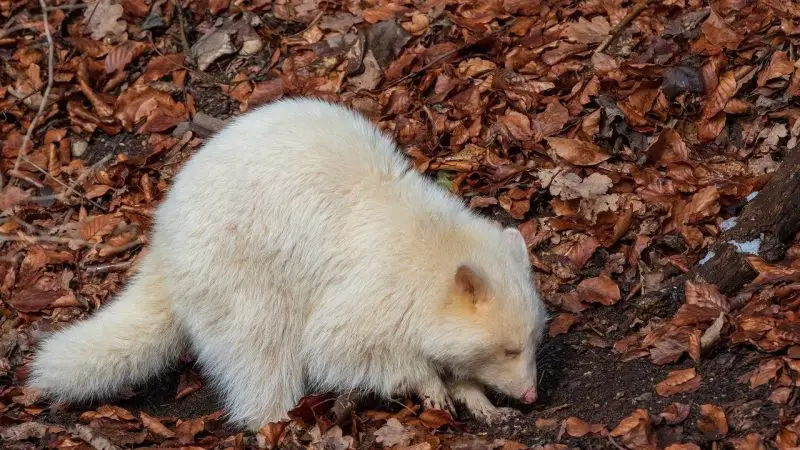When someone mentions raccoons, most people imagine the classic masked creature with black rings around its tail and curious little hands searching for food in the dark. But what if you saw one that was completely white, with pink eyes and pale fur? It would be easy to assume it’s a ghost or an urban legend. In Tennessee, tales of “albino raccoons” have sparked curiosity and debate for years. Are they truly real, or just another backwoods myth born out of imagination?
This article takes you deep into the mysterious world of albino raccoons in Tennessee. You’ll discover what science says about their existence, how to tell an albino raccoon from a regular one, where sightings have occurred, and why these rare animals fascinate so many nature enthusiasts across the state.
Understanding Albinism in Wildlife

Albinism is a rare genetic condition that affects both humans and animals. It occurs when the body fails to produce melanin, the pigment responsible for coloring skin, hair, and eyes. Without melanin, creatures appear white or pale, often with pink or red eyes caused by visible blood vessels.
In wildlife, albinism can occur in nearly any species, including birds, deer, snakes, and even raccoons. The condition is not limited by location, but environmental and genetic factors may influence how often it appears in certain populations. Since Tennessee has abundant raccoon populations and dense forested areas, the odds of a genetic mutation occasionally surfacing are quite possible.
However, true albinism should not be confused with leucism, another condition that also leads to pale coloration. Understanding this distinction is key to identifying whether Tennessee’s white raccoons are genuinely albino or simply leucistic.
Albino vs. Leucistic Raccoons: What’s the Difference?
At first glance, a white raccoon might seem albino, but not every white raccoon fits that definition. Albinism involves a complete lack of melanin throughout the body, resulting in pink eyes, pink noses, and often poor eyesight. Leucism, on the other hand, is a partial loss of pigmentation, which allows for lighter fur but normal eye and skin color.
In Tennessee, most “white raccoon” sightings reported by locals tend to describe animals with normal-colored eyes or faint markings, which suggests leucism rather than true albinism. Leucistic raccoons can still have brown eyes and faint tail rings, while albino raccoons are completely devoid of color.
To identify an albino raccoon, look for three key traits:
- Pure white fur with no markings
- Pink or reddish eyes
- Pale skin and pink nose
If any of these features are missing, the raccoon is likely leucistic instead of albino.
Are Albino Raccoons Really Found in Tennessee?
The short answer is yes, albino raccoons do exist in Tennessee, but they are extremely rare. Wildlife biologists estimate that only one in every 750,000 raccoons is born with true albinism. Given the large raccoon population in the state, the odds of encountering one are slim, but not impossible.
Over the years, various sightings have been reported across Tennessee—from the wooded hills of East Tennessee to the suburban neighborhoods of Middle Tennessee. In some cases, photos or videos have surfaced online, showing striking white raccoons rummaging through trash bins or crossing backroads at night. While skeptics often question their authenticity, wildlife experts have verified several genuine cases.
These rare creatures are not mythical; they are simply products of a genetic twist. The rarity of albinism, combined with the raccoon’s nocturnal and elusive nature, makes sightings remarkable events for anyone lucky enough to witness one.
Historical Sightings and Local Reports in Tennessee
Tennessee has a long history of unusual wildlife sightings, and albino raccoons are among the most fascinating. Reports date back several decades, particularly in rural counties where raccoons are common.
In 2012, a wildlife enthusiast in Sevier County photographed what appeared to be an albino raccoon near the foothills of the Smoky Mountains. The animal had snow-white fur, pinkish eyes, and no visible dark markings. Wildlife officials later confirmed it was a genuine albino.
More recently, in 2021, social media posts from Williamson County circulated widely showing an all-white raccoon near a residential area. Many users initially thought the creature was a cat or opossum until closer examination revealed its unmistakable raccoon features.
Although official records are rare, anecdotal accounts from hunters, hikers, and homeowners continue to add to the mystique surrounding these ghostly animals.
Why Albino Raccoons Are So Rare
The genetic basis of albinism explains its rarity. The condition results from a recessive gene, which means both parents must carry and pass the same defective gene for a baby raccoon to be albino. Since this gene combination is rare, it seldom occurs in wild populations.
Additionally, albino raccoons face survival challenges that make their lives shorter and more difficult. Their lack of camouflage makes them visible to predators such as owls, coyotes, and bobcats. Poor eyesight, a common side effect of albinism, can also hinder their ability to navigate forests or locate food.
Because of these disadvantages, albino raccoons rarely survive long in the wild, further reducing the chances of encountering one in adulthood. Those that do survive often inhabit safe zones near human settlements, where predators are fewer and food sources more predictable.
Physical Characteristics of Albino Raccoons
Albino raccoons look strikingly different from their typical gray and black relatives. Their entire coat is bright white, sometimes with a faint cream tint due to environmental exposure. They have pink eyes that may appear red when caught in light, and their noses and paws are pale pink as well.
Despite their color difference, albino raccoons retain the same body shape and size as regular raccoons. Adults typically measure between 16 and 28 inches long and weigh 8 to 20 pounds, depending on food availability and habitat.
Their white fur may appear elegant, but it provides no advantage in the wild. In Tennessee’s dark woods and lush vegetation, such coloration makes them stand out, making stealth and protection more difficult.
Behavior and Lifestyle
Albino raccoons share the same habits as normal raccoons. They are nocturnal, highly intelligent, and opportunistic feeders. In Tennessee, they thrive in environments with abundant water sources such as rivers, creeks, and swamps. Their diet includes fruits, nuts, insects, frogs, and even human leftovers.
However, because of their poor eyesight and increased vulnerability, albino raccoons often behave more cautiously. Some researchers believe they may rely more on touch and hearing than sight when foraging. This heightened caution might explain why sightings are so uncommon—they are more likely to avoid human contact.
Like their darker counterparts, albino raccoons are curious and adaptable. They can survive near farms, suburban neighborhoods, and forest edges, making Tennessee’s mixed landscape an ideal setting for their survival, at least temporarily.
The Role of Genetics in Albinism
At the heart of every albino raccoon lies a simple genetic mutation. This mutation affects the TYR gene, responsible for producing an enzyme that enables melanin synthesis. When this enzyme fails, the result is albinism. Because the condition is recessive, both parents must carry this rare mutation.
Interestingly, these genetic quirks are not tied to geography. That means raccoons across Tennessee have roughly the same chance of producing an albino offspring as those in other parts of North America. The condition does not favor a specific region but can emerge anywhere raccoons are found in large numbers.
In captivity, breeders and wildlife rehabilitators have occasionally raised albino raccoons, confirming their existence and helping researchers better understand the condition. These controlled environments also provide rare opportunities to study their behavior without the constant risk of predation.
How to Identify an Albino Raccoon in the Wild
Spotting an albino raccoon in the wild is a thrilling experience, but correct identification is crucial. Many Tennessee residents have mistaken pale or dusty raccoons for albinos, when in fact these animals simply have lighter fur or suffer from temporary conditions like mange.
If you happen to encounter a white raccoon, use these identification tips:
- Check the eyes: True albinos have pink or reddish eyes that stand out under light.
- Look for markings: Albino raccoons have no black rings or face masks. If faint rings exist, it is likely leucistic.
- Observe behavior: Albinos may seem slower or more hesitant due to visual impairments.
- Avoid close contact: As with all wild animals, admire from a distance and never attempt to touch or capture it.
Myths and Folklore Surrounding White Raccoons in Tennessee
In Tennessee’s rural culture, strange animal sightings often find their way into folklore. White raccoons have been linked to superstitions and symbolic meanings for generations. Some local traditions consider them omens of good luck, while others view them as spiritual messengers or rare natural wonders.
Native American legends across the Southeast also mention white animals as symbols of purity or connection to the spirit world. Although there is no scientific evidence to support these beliefs, they reflect the awe and respect people feel toward rare creatures.
In modern times, the mystique surrounding albino raccoons has shifted from superstition to scientific fascination. Wildlife photographers and enthusiasts view them as symbols of nature’s unpredictability and genetic diversity.
Are Albino Raccoons Dangerous?
Despite their eerie appearance, albino raccoons are not more dangerous than regular raccoons. They have the same instincts and behaviors, including curiosity and occasional boldness when searching for food near humans.
Like all raccoons, they can carry diseases such as rabies or raccoon roundworm, but these risks are no greater for albino individuals. The biggest threat in most encounters comes from humans rather than the animal itself. Some people, driven by fear or misunderstanding, have harmed or captured albino raccoons, further reducing their already small population.
If you spot one, the best approach is to observe from a safe distance and notify local wildlife officials if the animal appears injured or trapped.
Conservation and Protection in Tennessee
Although raccoons are not endangered, albino raccoons represent a rare genetic expression worth preserving. In Tennessee, it is illegal to harm or kill wildlife without proper permits, which provides basic protection for these unique animals.
Wildlife rehabilitation centers occasionally receive albino raccoons that were orphaned, injured, or removed from unsafe environments. These facilities play a vital role in protecting and studying them. When possible, rehabilitated individuals are released back into the wild, though some are kept in sanctuaries for educational purposes.
Public awareness also helps protect them. Encouraging people to appreciate, rather than fear, these unusual animals ensures their continued presence in Tennessee’s natural landscape.
Why Albino Raccoons Fascinate People
There’s something captivating about a creature that defies the norm. Albino raccoons represent mystery, rarity, and the fragile balance of nature. Their ghostly appearance contrasts with their playful intelligence, creating a blend of beauty and oddity that captures public imagination.
For photographers and wildlife lovers, encountering an albino raccoon is a once-in-a-lifetime experience. The combination of rarity, photogenic contrast, and mythic associations makes them one of Tennessee’s most talked-about wildlife curiosities.
Their presence also reminds us that nature is full of genetic surprises, constantly producing variations that keep ecosystems diverse and fascinating.
How Common Are Albino Raccoons in Other States?
While Tennessee has its share of sightings, albino raccoons have also been reported in neighboring states such as Kentucky, North Carolina, and Alabama. This pattern suggests that albinism occurs sporadically throughout raccoon populations across the eastern United States.
In 2019, an albino raccoon was photographed in Ohio, and another was spotted in Florida in 2022. These sightings, though scattered, show that the condition is not confined to a single region but appears randomly where genetic combinations align.
Thus, Tennessee’s albino raccoons are part of a larger pattern of natural rarity, adding to the mystique of wildlife diversity across the continent.
Observing Albino Raccoons Responsibly
If you ever encounter an albino raccoon, resist the urge to chase or photograph it too closely. Flash photography can startle nocturnal animals and worsen vision problems. Instead, observe quietly from a distance using natural or low lighting.
Reporting sightings to the Tennessee Wildlife Resources Agency (TWRA) can also help researchers track and study the distribution of albino raccoons statewide. Such data supports conservation awareness and ensures these animals remain part of Tennessee’s natural heritage.
Remember, your sighting contributes valuable information about wildlife diversity and helps dispel myths about these mysterious creatures.
Fun Facts About Albino Raccoons
- Albino raccoons are not a separate species – they are simply raccoons with a genetic mutation.
- They are nocturnal like normal raccoons, though their poor vision may alter their activity patterns.
- Their lifespan in the wild is shorter, often less than three years, due to visibility and predation risks.
- They can exist in captivity for up to ten years when protected from natural threats.
- Each albino raccoon is genetically unique, even though they all share the same lack of melanin.
FAQs About Albino Raccoons in Tennessee
Are albino raccoons legal to own as pets in Tennessee?
No. It is illegal to capture, keep, or domesticate wild raccoons, including albino ones, without a special wildlife permit. Raccoons can carry diseases and require specialized care not suitable for home environments.
Do albino raccoons survive in the wild?
Survival is difficult. Their lack of camouflage and vision problems make them easy prey. However, those that live near human areas may survive longer due to reduced predation and easy food access.
How often are albino raccoons born?
Estimates suggest about one in every 750,000 raccoons is albino, making the condition exceptionally rare.
Can an albino raccoon reproduce?
Yes, but only if it mates with another carrier of the recessive gene can their offspring also be albino. Otherwise, babies will have normal coloration.
What should I do if I see an albino raccoon?
Observe from a distance and avoid interfering. If the animal seems sick or injured, contact local wildlife authorities for guidance.
Final Thoughts
So, are albino raccoons in Tennessee real or myth? The answer is clear—they are absolutely real, though incredibly rare. These pale wonders of nature captivate Tennesseans with their beauty and mystery, bridging the gap between science and folklore. Every sighting reminds us that even in familiar forests, extraordinary surprises await those who look closely.
Their existence tells a story of resilience and adaptation, even against genetic odds. While myths once painted them as supernatural messengers, modern understanding reveals them as living proof of nature’s unpredictability. Whether seen in the wild or preserved in memory, albino raccoons will always remain one of Tennessee’s most enchanting wildlife enigmas.






